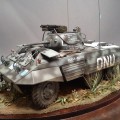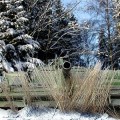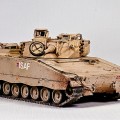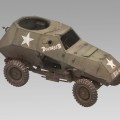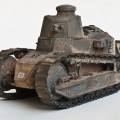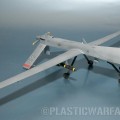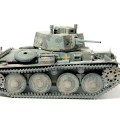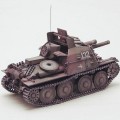There are countless discussions on various forums regarding painting of tracks and how much tension there should be. Here are some reflections by us, Erik and Thord, regarding track tension and painting. We´ll look at track tension first.
As with everything else when it comes to modelling one has to study the subject carefully. Tracks are “living creatures” and the look of the tracks change depends on many variables. One vehicle might have a fresh set of tracks and the tension set correctly, that vehicle might have very taut tracks with almost no hang whatsoever. Another vehicle might have very worn tracks and the tension unadjusted, resulting in the tracks following the upper contours of the roadwheels. Some vehicles gladly work even without taut tracks, some vehicles might be prone to shred tracks if they are not tight enough, which means that the crew are more likely to adjust the tension more often.
Movement also affect the appearance of the tracks. During accelleration the drive sprocket pulls the track and depending on wether the sprocket sits in the front or to the rear this gives a different result. If the sprocket sits up front, as it does on most ww2 tanks and most modern APC´s the track running above the road wheels, all the way to the idler will be tensioned, while the slack will collect in front of the first road wheel. If the sprocket is mounted to the rear, the opposite will occur. The sprocket will pull the track from underneath the rearmost roadwheel, making the track from the rear roadwheel to the sprocket very taut. The track running from the sprocket all the way to the idler will then have more slack than normal. The same thing goes for when the vehicle is turning. Tracked vehicles normally turn by breaking on one side, and accellerating on the other.
[inspic=771,left,fullscreen,thumb] Here you can see two Pbv 401 (MTLB´s in the Swedish army). Notice how the tracks follow the contours of the roadwheels on the vehicle in the back. Apparently the MTLB is able to function even with very loose tracks. The tracks on the vehicle in front is more taut, but notice the slack in front of the drive sprocket. Now, look at the rear, and the track on the other side. Here you can see a bit more slack, which indicates that the track run closest to camera is accellerating, but not the other side, which means that the vehicle is turning slightly.
[inspic=772,left,fullscreen,thumb] This is the same vehicle as the one in the back on the picture above. Notice how the tracks really hang on this one. This lack of tension is not very common, and when I replicated it on my Pbv 401 modell I got comments on how unrealistic it looked. Well. For this particular vehicle it´s not. But on a Leopard 2, or an M1A2 Abrams the story is different.
Many tanks use so called live tracks. On these tracks the track pins sits in rubber bushings, which prevents the pin from rotating in the track link. The links are then mounted at angle to each other. The rubber bushings will then flex to allow the track to run arount the sprocket and idler, but it will also dampen out some of the track movement and it will appear tighter. But this doesn´t mean that modern vehicles with live tracks don´t have any slack at all. But the slack on vehicles like Leopard 2 and Abrams is considerably less. On vehicles that lacks return rollers there is still plenty of visible slack.
